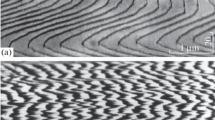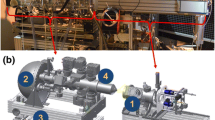Abstract
A high-temperature Auger electron spectroscopy setup and its in situ application to sessile drop experiments of molten silicon on oxide substrates are presented. The experimental setup allows for measurements of previously inaccessible surface reactions at temperatures up to 1700 K. Auger electron spectra of SiO2, MgO, and liquid Si are presented. Furthermore, the areas of the substrates that have been transiently wetted by the silicon melt are investigated. The results are discussed with respect to questions concerning reactive wetting of oxides by metal melts, which are important for the material science of joining processes.








Similar content being viewed by others
References
Szalkowski FJ (1972) Auger electron spectroscopy investigations of the surface chemical composition of vanadium, the vanadium oxides, and oxidized vanadium: chemical shift and peak intensity analysis. J Chem Phys 56:6097. doi:10.1063/1.1677160
French TM, Somorjai GA (1970) Composition and surface structure of the (0001) face of.alpha.-alumina by low-energy electron diffraction. J Phys Chem 74:2489–2495. doi:10.1021/j100706a014
Weil KS, Hardy JS (2006) Brazing a mixed ionic/electronic conductor to an oxidation resistant metal. In: Lewinsohn CA, Singh M, Loehman R (eds) Advances in joining of ceramics. John Wiley & Sons, Inc., Hoboken, NJ, pp 185–200
Jadoon AK (2007) Editorial. J Mater Sci 43:1. doi:10.1007/s10853-007-2217-2
Singh M, Shpargel TP, Asthana R (2007) Brazing of yttria-stabilized zirconia (YSZ) to stainless steel using Cu, Ag, and Ti-based brazes. J Mater Sci 43:23–32. doi:10.1007/s10853-007-1985-z
Lewinsohn CA, Singh M, Loehman R (2006) Front matter. In: Advances in joining of ceramics. John Wiley & Sons, Inc., Hoboken, NJ, pp i–vii
Drevet B, Eustathopoulos N (2012) Wetting of ceramics by molten silicon and silicon alloys: a review. J Mater Sci 47:8247–8260. doi:10.1007/s10853-012-6663-0
Dezellus O, Hodaj F, Rado C et al (2002) Spreading of Cu–Si alloys on oxidized SiC in vacuum: experimental results and modelling. Acta Mater 50:979–991. doi:10.1016/S1359-6454(01)00397-4
Gibbs JW (1948) The collected works: thermodynamics. Yale University Press, New Haven
Cammarata RC (2008) Generalized surface thermodynamics with application to nucleation. Philos Mag 88:927–948. doi:10.1080/14786430802014654
Alphei LD, Grotjahn R, Becker V et al (2013) Reaction enhanced wetting of quartz by silicon droplets and its instabilities. J Mater Sci 48:7350–7359. doi:10.1007/s10853-013-7587-z
Evers J, Klüfers P, Staudigl R, Stallhofer P (2003) Czochralski’s creative mistake: a milestone on the way to the Gigabit Era. Angew Chem Int Ed 42:5684–5698. doi:10.1002/anie.200300587
Müller G, Mühe A, Backofen R et al (1999) Study of oxygen transport in Czochralski growth of silicon. Microelectron Eng 45:135–147. doi:10.1016/S0167-9317(99)00115-X
Togawa S, Izunome K, Kawanishi S et al (1996) Oxygen transport from a silica crucible in Czochralski silicon growth. J Cryst Growth 165:362–371. doi:10.1016/0022-0248(96)00211-4
Smirnov AD, Kalaev VV (2008) Development of oxygen transport model in Czochralski growth of silicon crystals. J Cryst Growth 310:2970–2976. doi:10.1016/j.jcrysgro.2008.03.002
Ferguson FT, Nuth JA (2008) Vapor Pressure of Silicon Monoxide. J Chem Eng Data 53:2824–2832. doi:10.1021/je800560b
Wachsmuth D, Gebensleben T, Weiß D et al (2012) SiO gas emission and triple line dynamics of small silicon droplets on quartz. J Cryst Growth 355:122–128. doi:10.1016/j.jcrysgro.2012.06.044
Weiß D, Gebensleben T, Diestel L et al (2011) The influence of crystallographic orientation on the wetting of silicon on quartz single crystals. J Mater Sci. doi:10.1007/s10853-010-5246-1
Chang CC (1971) Auger electron spectroscopy. Surf Sci 25:53–79. doi:10.1016/0039-6028(71)90210-X
Palmberg PW, Rhodin TN (1968) Auger electron spectroscopy of fcc metal surfaces. J Appl Phys 39:2425–2432. doi:10.1063/1.1656571
Johannessen JS, Spicer WE, Strausser YE (1976) An Auger analysis of the SiO2-Si interface. J Appl Phys 47:3028–3037. doi:10.1063/1.323047
Briggs D, Seah MP (1990) Practical surface analysis, 2nd ed edn. Wiley; Salle+Sauerländer, Chichester; New York; Aarau
Stojilovic N, Bender ET, Ramsier RD (2005) High-temperature Auger electron spectroscopy of Zircaloy-4. Appl Surf Sci 252:1806–1811. doi:10.1016/j.apsusc.2005.03.130
Bas EB, Bänninger U (1974) High temperature Auger-electron spectroscopy. Surf Sci 41:1–10. doi:10.1016/0039-6028(74)90292-1
Goumiri L, Joud JC (1982) Auger electron spectroscopy study of aluminium-tin liquid system. Acta Metall 30:1397–1405. doi:10.1016/0001-6160(82)90160-2
Chao SS, Tyler JE, Takagi Y et al (1986) A study of chemical bonding in suboxides of silicon using Auger electron spectroscopy. J Vac Sci Technol A 4:1574–1579. doi:10.1116/1.573510
Helms CR, Strausser YE, Spicer WE (1978) Observation of an intermediate chemical state of silicon in the Si/SiO2 interface by Auger sputter profiling. Appl Phys Lett 33:767–769. doi:10.1063/1.90498
Braun AM (2010) Augerelektronenspektroskopie an Halbleiterschmelzen. Diplomarbeit, Gottfried Wilhelm Leibniz Universität
Guo H, Maus-Friedrichs W, Kempter V (1997) Charging Phenomena and Charge Compensation in AES on Metal Oxides and Silica. Surf Interface Anal 25:390–396. doi:10.1002/(SICI)1096-9918(199706)25:6<390:AID-SIA247>3.0.CO;2-X
Ishizaka A, Shiraki Y (1986) Low Temperature Surface Cleaning of Silicon and Its Application to Silicon MBE. J Electrochem Soc 133:666–671. doi:10.1149/1.2108651
Tromp R, Rubloff GW, Balk P et al (1985) High-temperature SiO2 decomposition at the SiO2/Si interface. Phys Rev Lett 55:2332–2335. doi:10.1103/PhysRevLett.55.2332
Liehr M, Lewis JE, Rubloff GW (1987) Kinetics of high-temperature thermal decomposition of SiO2 on Si(100). J Vac Sci Technol A 5:1559–1562. doi:10.1116/1.574564
Palmberg PW (1972) Handbook of Auger electron spectroscopy: a reference book of standard data for identification and interpretation of Auger electron spectroscopy data. Physical Electronics Industries, Minneapolis
Smith JN, Thomas S, Ritchie K (1974) Auger electron spectroscopy determination of the oxygen/silicon ratio in spin-on glass films. J Electrochem Soc 121:827–829. doi:10.1149/1.2401928
Nagamori M, Boivin J-A, Claveau A (1995) Gibbs free energies of formation of amorphous Si2O3, SiO and Si2O. J Non-Cryst Solids 189:270–276. doi:10.1016/0022-3093(95)00239-1
Gebensleben T (2014) Simulation des Sauerstofftransports an Si(l)/SiO2(s)-Grenzfläachen mit einem Markov-Ketten-Algorithmus. Masterarbeit, Leibniz Universität Hannover
MgO (100) Substrate 10x10x0.5 mm, 2SP. In: MTI Corp - Lead. Provid. Lab Equip. Adv. Cryst. Substrates. http://www.mtixtl.com/mg-a-101005s2.aspx. Accessed 27 Sept 2014
McCune RC, Wynblatt P (1983) Calcium segregation to a magnesium oxide (100) surface. J Am Ceram Soc 66:111–117. doi:10.1111/j.1151-2916.1983.tb09985.x
Gröbner J, Chumak I, Schmid-Fetzer R (2003) Experimental study of ternary Ca–Mg–Si phase equilibria and thermodynamic assessment of Ca–Si and Ca–Mg–Si systems. Intermetallics 11:1065–1074. doi:10.1016/j.intermet.2003.07.001
Acknowledgements
We are grateful to Wacker Siltronics for the provided ultrapure silicon. We acknowledge discussions with Prof. R. Imbihl concerning surface diffusion questions, as well as D. Wachsmuth for his help with the lab work, discussions, and comments on the manuscript.
Author information
Authors and Affiliations
Corresponding author
Rights and permissions
About this article
Cite this article
Alphei, L.D., Dobbe, C., Becker, V. et al. A high-temperature Auger electron spectrometer setup and its application to reactive wetting experiments at 1700 K. J Mater Sci 50, 3175–3182 (2015). https://doi.org/10.1007/s10853-015-8879-2
Received:
Accepted:
Published:
Issue Date:
DOI: https://doi.org/10.1007/s10853-015-8879-2




